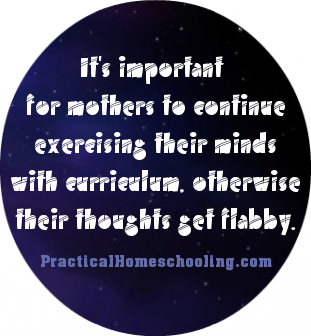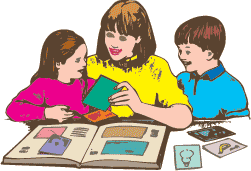 Mother Culture is the title of my favorite topic for speaking engagements. Whenever I present this talk, to encourage homeschooling mothers, I bring along the funny-looking mittens I've made. They are strewn about my book table to remind mothers to take part in Mother Culture. Mittens are a small project that can be completed in several sittings but provide that feeling of accomplishment I sometimes long for. Mittens exercise my creativity and imagination. The children are curious and happy to see Mommy making something, too.
Mother Culture is the title of my favorite topic for speaking engagements. Whenever I present this talk, to encourage homeschooling mothers, I bring along the funny-looking mittens I've made. They are strewn about my book table to remind mothers to take part in Mother Culture. Mittens are a small project that can be completed in several sittings but provide that feeling of accomplishment I sometimes long for. Mittens exercise my creativity and imagination. The children are curious and happy to see Mommy making something, too.
What is Mother Culture?
Mother Culture is living the educational life with our children by learning alongside of them. A mother may enjoy learning new subjects with her children. When a mother experiences afresh the wonderful things brought forth in Charlotte Mason's wide curriculum - subjects I've discussed in more detail in past articles - she is learning a little more, exploring, and contemplating off to the side for her own benefit as well. Perhaps a mother would like to create her own Nature Diary with watercolor pictures and descriptions of her bird watching or wild flower finds. She might pick up an 18th-century novel or book of poetry. She may announce that it is time to play "Mommy's music," or play "Mommy's game" of badminton or croquet. Or she may plan an outing to an art museum alone with her husband.
Dabbling
Dabbling in little projects calms the nerves. Dabbling provides diversion and a rest from the usual routine. And oh, how satisfying it is for a mom to decorate the windows of her bedroom with home-sewn curtains, wrap baby in something she's made by hand, or take a photograph of her children wearing the clothes or sweaters she made them. Her husband may even become a recipient of her wares if she becomes proficient enough and he graciously concedes.
Having interests and hobbies gives us things to share in common with our neighbors, neighbors who might not know God and would benefit from our friendliness or the gospel.
 A Continual Supply of Ideas
A Continual Supply of Ideas
Charlotte Mason advised the teacher to replenish her soul with a continual supply of ideas. "Never be without a really good book on hand," she said. "If you find yourself sinking to a dull commonplace level, with nothing particular to say, the reason is probably that you are not reading and therefore not thinking . . . If you will read and ponder your Parents' Review . . . you will find that it stimulates your educational thought in many directions and keeps you from drifting into mere routine . . . Do not think this is a selfish thing to do because the advantage does not end with yourself. . . The more you study on your spare time, the more there is in you to bestow upon your pupils."1.
"Whatever is down in the well is going to come up in the bucket," said a country man. If a mother lets her well run dry or the water become stagnant she will make trouble for herself thereafter. Her children may grow up with the "Oh, it's only Mother" attitude in their voice. Some children may eventually think they know more than Mother on all points.
Living Books . . . for Mom!
Where do we get ideas? From what Charlotte called "living books." These are real books (not school textbooks) written on a variety of subjects, usually by one author who is fond of his topic. These books are alive with ideas. I believe that a wide curriculum in which the Bible and real books, "living books," are included makes for a more interesting education than most school systems afford. It gives the whole family much to think about, something to talk about.
But a mother must gather ideas to ponder for herself from a good book of her own choosing. Some mothers may say, "I have no time for myself." Others, "I don't think it is right to think of myself." Such mothers are stuck in a rut of self-sacrifice to the extent that they are starving themselves spiritually, mentally, and, consequently, emotionally. But all this can change. A fresh wind of change will revive the mother who takes part in Mother Culture, who provides herself a Charlotte Mason style of education.
Bible Plus Three
The habit of grown-ups reading living books and retaining the power to digest them will be lost if we refuse to give a little time for Mother Culture. A wise mother, an admired mother and wife, when asked how, with her weak physical health and many demands on her time, she managed to read so much said, "Besides my Bible, I always keep three books going that are just for me - a stiff book, a moderately easy book, and a novel or one of poetry. I always take up the one I feel fit for. That is the secret: always have something 'going' to grow by."
The Bible
A quiet time with God is essential. Prayer and meditation will open the Christian heart to the love of God. To meditate on God's word is not to hurry. Let a hush replace the rush and so dwell on God's word that it becomes written on the heart.
Gratitude will take the place of self-pity when a mother counts her blessings. She greatly needs this because self-sacrificing love is the essence of motherhood. And for mothers, "love" is a very busy verb.
Three Other Books
A mother can understand and reflect on spiritual matters related to the world around her through her choice of books: biographies, histories, poetry, good novels, or even books on tending a garden, craftsmanship, or the domestic arts.
One Example
This year, during the dark days of winter, I read Thomas Hardy's Far From the Madding Crowd. It uses challenging vocabulary to describe farm life in 19th-century England. A young lady, Bathsheba, suddenly finds herself owner of her uncle's farm. She may run the farm well, but she doesn't always make the most prudent decisions in her private life. The shepherd Gabriel Oak serves her on the farm and supports her through some crushing circumstances. He is an example of altruism, a quiet hero. This piece of literature is an excellent choice for high-school reading. The strengths and weaknesses of the characters provide discussion on virtue and how small vices can lead to large consequences. To put it in Victorian terms, I feel I've "improved myself" by reading this book. It widened my horizons a little. For me, it was a book to grow by. But it is just one example.
Artist John Ruskin, the great champion of the Pre-Raphaelite painters, said, "Make yourselves nests of pleasant thoughts, bright fancies, faithful sayings; treasure-houses of precious restful thoughts, which care cannot disturb nor poverty take away from you, houses built without hands for your souls to live in." Beautiful thoughts and noble ideas, beautiful pictures, beautiful music, and the beauty of nature all have a way of reviving the soul. The spirit lifts higher when we admire.
Bibliography:
1. The Story of Charlotte Mason by Essex Cholmondeley, Parent's National Education Union 1960, page 162.
2. A Charlotte Mason Companion by Karen Andreola